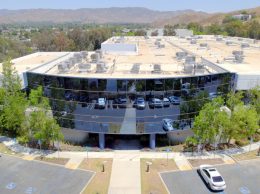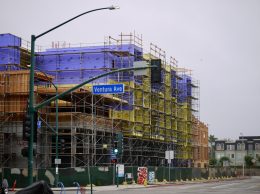Foreclosure fiasco’s ground zero: Ventura County offices churned out paperwork
IN THIS ARTICLE
- Top Stories Topic
- Marlize van Romburgh Author
By Marlize van Romburgh Monday, October 25th, 2010

“I didn’t count how many I processed, but it was a lot,” she said. “Maybe about 500 a day.”
Martins-Mann was a foreclosure technician at Countrywide’s Simi Valley offices until the mortgage lender was acquired by Bank of America in 2008.
She now says that blowing through paperwork was part of the Countrywide culture in the years before Bank of America — which recently froze foreclosures as it looks into allegedly sloppy recordkeeping — stepped in to rescue the company.
“We were always being rushed to get more done; more and more and more,” Martins-Mann said. “They didn’t seem to care about errors or you getting things right. They just rushed you to do more work, and that was the way the whole company worked.”
Simi Valley — the former home of Countrywide’s loan servicing center — now appears to be at the epicenter of the battle over the housing meltdown, mortgages and more recently, foreclosure paperwork. Ironically, the financial nightmare that’s cost millions of people their homes may bring more work to Ventura County as Bank of America ramps up hiring there and around the country.
Bank of America employed about 3,800 people in Ventura County as of 2009. Company spokesperson Rick Simon declined Business Times requests for updated employee numbers, but if the count has stayed in that range, Bank of America remains Ventura County’s second largest private employer. Its Simi Valley operation is still the national bank’s largest mortgage processing facility, Simon said.
Brian Gabler, Simi Valley’s economic development director, said the city expects hiring at Bank of America’s local offices to increase.
“When they start ramping up their foreclosure business, they actually staff up,” he said.
The company also recently leased back a 75,000-square-foot space in the city for two years. “Clearly there’s some incentive for them to stay here,” Gabler said.
Despite ugly headlines about the foreclosure mess, the company is a welcome employer, he said. “Anything that can provide more employment opportunities for our residents, we’re all in favor of,” he said.
Simon said that nationwide, Bank of America aggressively ramped up hiring across the country starting in January. “There has been some gain in Simi Valley and other California locations,” including Westlake Village, he said.
Foreclosure freeze
Bank of America was the first of several large lenders to voluntarily freeze residential foreclosures in all 50 states, after widely reported accounts of bungled paperwork leading to potentially erroneous home repossessions.
The nation’s largest bank said Oct. 18 it would lift the moratorium in the 23 states that require court approval to force delinquent homeowners out of their houses. The freeze will continue in the remaining 27 states as foreclosures are reviewed on a case-by-case basis. California does not require court approval for most foreclosures.
The foreclosure freeze stems from reports that Bank of America and other lenders used “robo-signers” — employees with little to no experience who signed off on hundreds of foreclosure documents a day — to process paperwork.
One Florida attorney representing 3,000 homeowners who claim they were wrongly foreclosed on said Bank of America and other financial institutions hired Wal-Mart floor employees, hair stylists and factory workers and installed them as “foreclosure experts” with little to no formal training.
According to the Associated Press, many of those workers testified in court that they barely knew what a mortgage was, and some couldn’t define the word “affidavit.” The Florida lawyer gathered 150 depositions from bank employees who said they signed foreclosure affidavits without reviewing the documents or ever laying eyes on them, the AP reported.
Countrywide’s portfolio
When Bank of America wed Calabas-based Countrywide in a government-assisted shotgun merger, it also acquired the failing mortgage giant’s portfolio of loans. Data from SNL Financial shows that Bank of America had about $18.7 billion mortgages in foreclosure when it imposed the freeze, second only to JPMorgan Chase & Co. with $19.5 billion.
“We have to believe that the former Countrywide portfolio of serviced loans must be a significant portion of B of A’s issues,” California Lutheran University economist Bill Watkins said in an e-mail to the Business Times.
Investment firms Pimco and BlackRock and the Federal Reserve Bank of New York are seeking to force Bank of America to repurchase $47 billion of soured mortgages that its Countrywide unit had packaged into bonds, Bloomberg News reported on Oct. 19. Allegedly insufficient record keeping and other servicing failures by Countrywide may open the door for more investors to seek repurchases.
Bank of America has said the issues relating to its mortgage and foreclosure processing policies are merely minor technical glitches.
“It’s going to take us three to five weeks to get through and actually get all of this taken care of. The teams reviewing the data have not found information which was inaccurate which would affect the plain facts of the foreclosure,” Bank of America CEO Brian Moynihan said in an Oct. 19 earnings call announcing the company’s $7.3 billion third-quarter loss.
‘They didn’t care’
Two years after being let go from Countrywide, Martins-Mann is still struggling to get back on her feet.
She was hired by the mortgage giant in 1998, after doing data entry for the company as a temporary worker, and spent 10 years with the firm. Most of that time was spent doing data entry, but she was transferred to the loan processing center in Simi Valley in 2008, about a month before she was laid off.
Martins-Mann said she would typically check information in the filings, such as phone numbers, before handing foreclosure documents off to other employees. “I’d look on the computer for certain kinds of information,” she said. “Sometimes I’d call attorneys to verify.”
But accuracy was not necessarily rewarded, she said.
“My error ratio was 0.03 percent. When I pointed that out to my supervisor, there was no pat on the back,” Martins-Mann said. “They didn’t care. They just wanted you to get back to work.”
Now, she’d be happy just to find work. She’s earned her marketing/communications degree from the University of Phoenix, owns her own Web design and personal training businesses and is looking for a new job — without success.
“It’s not easy, that’s for sure. With unemployment over 10 percent, it’s hard to compete with everybody else,” she said. “Everybody keeps telling me I don’t have enough experience.”










